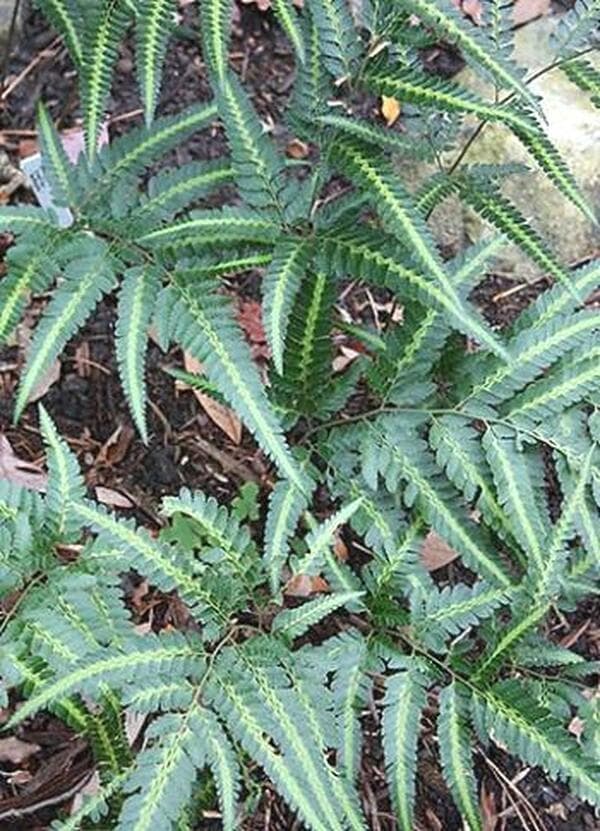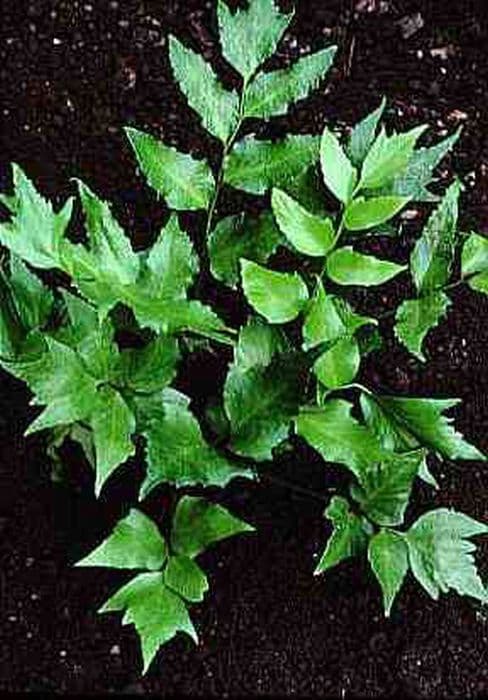Male fern Dryopteris filix-mas 'Crispa Cristata'











ABOUT
The male fern, with its unique 'Crispa Cristata' variety, is a striking plant characterized by its highly textured fronds. This plant features a lush clump of foliage that possesses an intricate, crisped, and crested appearance, providing an ornamental quality unlike the more typical smooth-edged fern varieties. Each frond is elegantly divided and carries a rich, deep green color that gives the plant a robust, dense look. The fronds themselves unfurl from the center of the plant in a vase-like form, creating an eye-catching rosette that radiates outward. As these fronds mature, they display a remarkable wavy or ruffled texture, with each leaflet dancing along the frond's axis, presenting an almost feathery and delicate aesthetic that adds a layer of depth and complexity to the plant's visual appeal. Owing to its dramatic foliage, the male fern 'Crispa Cristata' can be a beautiful focal point in shady garden areas or wooded landscapes where it can spread its fronds to create a lush, prehistoric ambiance. The contrast of its vibrant green against the brown of the soil or the shade of other plants brings a lively burst of color that enhances the atmosphere of any garden setting. The plant's texture and form make it seem almost as if it were a living sculpture, shifting and changing throughout the growing season. Always a talking point, its fanciful fronds could be likened to intricate woodland lace, offering both visual interest and a touch of elegance to its surroundings. Despite its complex appearance, it blends harmoniously with other shade-loving plants.
About this plant
 Names
NamesFamily
Dryopteridaceae.
Synonyms
Male Fern, Male Shield Fern, Buckler Fern, King Fern.
Common names
Dryopteris filix-mas 'Crispa Cristata'.
 Toxicity
ToxicityTo humans
The common name for Dryopteris filix-mas 'Crispa Cristata' is Male Fern. Male Fern is not typically considered toxic to humans. However, like many plants, it is not intended for ingestion, and consuming parts of the plant, particularly in large quantities, could potentially lead to gastrointestinal irritation or discomfort.
To pets
Male Fern is not commonly listed as toxic to pets. However, pets should not be encouraged to eat ornamental plants as they can sometimes have a mild gastrointestinal upset if they consume parts of the plant. If a pet ingests a considerable amount of Male Fern, it would be prudent to monitor for any signs of distress and consult a veterinarian.
 Characteristics
CharacteristicsLife cycle
Perennials
Foliage type
Evergreen
Color of leaves
Green
Height
2 feet (0.61 meters)
Spread
2 feet (0.61 meters)
Plant type
Fern
Hardiness zones
4
Native area
Europe
Benefits
 General Benefits
General Benefits- Landscape and Aesthetic Appeal - Adds texture and visual interest to gardens with its crisped and crested fronds.
- Low Maintenance - Once established, it is relatively easy to care for with minimal watering and feeding requirements.
- Shade Tolerance - Thrives in shady areas where other plants may struggle to grow, making it ideal for wooded gardens or shaded borders.
- Wildlife Habitat - Provides shelter and habitat for various species of insects and small wildlife.
- Soil Erosion Control - The fern’s dense root system can help to stabilize soil and prevent erosion on slopes or in areas with loose soil.
- Seasonal Interest - Offers year-round interest with its evergreen foliage, particularly in temperate climates.
- Non-Invasive - Unlike some other ferns, this species is non-invasive, making it a responsible choice ecologically for many gardens.
 Medical Properties
Medical Properties- Anthelmintic properties: Male fern, which Dryopteris filix-mas is commonly known as, has been used historically for its ability to expel worms, particularly tapeworms, from the human body.
- Astringent qualities: The plant has been applied for its potential to cause contraction of body tissues and has been used to stop bleeding and diarrhea.
- Anti-inflammatory: Male fern has been considered for its possible inflammation-reducing effects in traditional medicine.
- Purgative effects: It has a history of use as a strong laxative, although such use is now recognized as dangerous without medical supervision.
 Air-purifying Qualities
Air-purifying QualitiesThis plant is not specifically known for air purifying qualities.
 Other Uses
Other Uses- Dye Production: The Dryopteris filix-mas 'Crispa Cristata', or male fern, can be used to create a natural dye, sourced from various parts of the plant, including the rhizomes and fronds.
- Furniture Decoration: Its unique and intricate frond structure can serve as a natural decorative element in the creation of rustic furniture pieces.
- Fern Prints: The textured fronds of the male fern can be used to make botanical prints on paper or fabric, which are popular in crafting and art projects.
- Garden Mulch: Dried fronds from the male fern can be repurposed as mulch to retain soil moisture and suppress weeds in garden beds.
- Vivariums: The male fern's tolerance of damp environments makes it an ideal plant to include in vivariums, providing aesthetic value and habitat structure.
- Floral Arrangements: The feathery fronds of the male fern can add volume and texture to floral arrangements, both fresh and dried.
- Erosion Control: The dense root system of the male fern can help stabilize soil and control erosion on slopes and banks in a landscaped area.
- Insulation Material: Historically, the dense fronds of male ferns were used for insulation in traditional building methods.
- Photography: Because of its unique form, the male fern is often used as an interesting subject in nature photography, both in its living environment or arranged as a still life.
- Composting: As the fern's fronds die back, they can be added to compost heaps where they contribute to the nutrient-rich humus over time.
Interesting Facts
 Feng Shui
Feng ShuiThe Male Fern is not used in Feng Shui practice.
 Zodiac Sign Compitability
Zodiac Sign CompitabilityThe Male Fern is not used in astrology practice.
 Plant Symbolism
Plant Symbolism- Protection: The Male Fern (common name of Dryopteris filix-mas 'Crispa Cristata') has been associated with protection. In some folklore, it is believed that ferns could ward off evil spirits.
- Secret Bond: Ferns in general are often connected to secrecy and the hidden due to their discreet way of reproducing through spores that are not always visible, hinting at hidden aspects or knowledge.
- Eternal Youth: Similarly to other ferns, the Male Fern could symbolize youth and the pursuit of immortality, possibly because of their ancient lineage and ability to thrive in various conditions.
- Shelter: The dense and lush growth of Male Ferns provides shelter to various species in the wild, symbolizing safety, accommodation, and hospitality.
- Health: Historically, the Male Fern has been used in herbal medicine, emblematic of good health and the healing of ailments, emphasizing its historical association with wellness.
 Water
WaterThe Male Fern should be watered deeply but infrequently, aiming to keep the soil consistently moist without becoming waterlogged. During active growth in spring and summer, you may need to water approximately once a week, providing about half a gallon of water for an average-sized plant. Reduce watering during the fall and further in winter to every two to three weeks, matching the plant's reduced growth and evaporation rates. Always check the top inch of the soil for dryness before watering, and avoid letting the plant stand in water as this can promote root rot.
 Light
LightThe Male Fern thrives in partial to full shade, making it an ideal choice for a spot that receives filtered sunlight or light that is dappled through overhead foliage. It can tolerate some morning sun but should be protected from harsh afternoon light which could scorch its delicate fronds. A north-facing garden or a location under the canopy of trees with high branches would be suitable for providing the optimal light conditions for this fern.
 Temperature
TemperatureThe Male Fern prefers temperatures between 55°F and 75°F and can withstand brief periods of colder temperatures down to 20°F. It's important to shield it from extreme heat, as prolonged exposure to temperatures above 80°F may stress the plant. Ideal growing conditions would be in a climate that maintains a fairly cool to moderate temperature range throughout the year, without major fluctuations.
 Pruning
PruningThe Male Fern benefits from pruning primarily to remove dead or damaged fronds, which can be done at any time of the year as needed. A more extensive pruning to tidy up the plant and encourage healthy new growth is best performed in early spring before new fronds emerge. Avoid excessive pruning, as the plant needs its fronds for photosynthesis and health.
 Cleaning
CleaningAs needed
 Soil
SoilThe Male Fern thrives best in a well-draining soil mix composed of one part garden soil, one part peat, and one part perlite or coarse sand. Aim for a slightly acidic to neutral pH ranging from 6.0 to 7.0 for optimal growth conditions.
 Repotting
RepottingMale Ferns typically require repotting every 2-3 years to prevent them from becoming root-bound and to refresh the soil. Always repot in the spring before the growing season begins.
 Humidity & Misting
Humidity & MistingThe Male Fern prefers high humidity levels, thriving best at 60-70% relative humidity. Ensuring adequate humidity is crucial for the fronds to develop fully and remain healthy.
 Suitable locations
Suitable locationsIndoor
Place Male Fern in indirect light, ensure high humidity, and keep the soil moist.
Outdoor
Plant Male Fern in partial shade, maintain moist soil, and mulch to retain moisture.
Hardiness zone
3-8 USDA
 Life cycle
Life cycleThe life of the Male Fern (Dryopteris filix-mas 'Crispa Cristata') starts as a spore, which upon finding suitable moist and shaded conditions, germinates to produce a small, heart-shaped gametophyte (prothallus). The gametophyte houses both male and female reproductive organs and under favorable conditions, fertilization occurs, giving rise to a young sporophyte, the initial stage of the fern plant. This juvenile sporophyte then develops into a mature fern, producing fronds that unfurl from tightly coiled croziers (fiddleheads) in a characteristic fern pattern. As the plant matures, it develops sori on the undersides of its fronds—these are clusters of sporangia where spores are produced. Once the spores are ripe, they are released to repeat the life cycle if they land in conducive conditions for growth. Through this life cycle, the Male Fern can live for many years, often growing larger and more robust with each passing season.
 Propogation
PropogationPropogation time
Spring to summer
The Male Fern, known scientifically as Dryopteris filix-mas 'Crispa Cristata', is typically propagated through spore collection. The best time to collect spores is during the summer when they are ripe and the spore cases, found on the underside of the fronds, are brown and crack open easily. These spores can then be sown on the surface of a fine sterilized soil mix, kept at a steady temperature of around 68 to 70 degrees Fahrenheit (20 to 21 degrees Celsius) and in indirect light. The soil should be kept moist, but not waterlogged, and covered with glass or plastic to maintain humidity. Germination can take several weeks to a few months, and upon development of the first true leaves, the young ferns can be gradually acclimated to less humid conditions and eventually potted on as individual plants.









